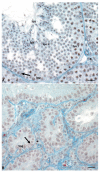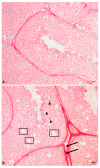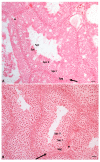The Italian Wall Lizard Podarcis siculus as a Biological Model for Research in Male Reproductive Toxicology
- PMID: 36499547
- PMCID: PMC9737876
- DOI: 10.3390/ijms232315220
The Italian Wall Lizard Podarcis siculus as a Biological Model for Research in Male Reproductive Toxicology
Abstract
Spermatogenesis is a genetically driven differentiation process that occurs in the testis and leads to the formation of spermatozoa. This process is extensively studied in several experimental models, particularly in vertebrates that share the morphological structure and functionality of the mammalian testis. Although reptiles are not generally considered biological models, the lizard Podarcis siculus has represented a suitable organism for the study of spermatogenesis over the years. In this lizard, the process of spermatogenesis is regulated by the interaction between systemic factors such as gonadotropins and local factors, i.e., molecules produced by the somatic and germinal cells of the testis. Many exogenous substances are able to alter the production of these regulative factors, thus altering the course of spermatogenesis, and P. siculus has proven to be an excellent model for studying the effects of various endogenous or exogenous substances on mechanisms underlying spermatogenesis. This review summarizes the available data on the effects of different substances on the control of spermatogenesis, highlighting the induced morphological and molecular alterations. Overall, the data show that sex hormone levels as well as the final stages of spermatogenesis are most affected by an imbalance of endogenous compounds or contamination by environmental pollutants. This is helpful for the male individual, since the damage, not affecting the spermatogonial stem cells, can be considered transient and not irreversible.
Keywords: endocrine disrupting compounds; environmental contaminants; reptiles; spermatogenesis; testis.
Conflict of interest statement
The authors declare no conflict of interest.
Figures




Similar articles
-
Could Exposure to Glyphosate Pose a Risk to the Survival of Wild Animals? A Case Study on the Field Lizard Podarcis siculus.Vet Sci. 2023 Sep 21;10(9):583. doi: 10.3390/vetsci10090583. Vet Sci. 2023. PMID: 37756105 Free PMC article. Review.
-
Glyphosate Interference in Follicular Organization in the Wall Lizard Podarcis siculus.Int J Mol Sci. 2023 Apr 17;24(8):7363. doi: 10.3390/ijms24087363. Int J Mol Sci. 2023. PMID: 37108525 Free PMC article.
-
Spermatogenesis and regulatory factors in the wall lizard Podarcis sicula.Gen Comp Endocrinol. 2020 Nov 1;298:113579. doi: 10.1016/j.ygcen.2020.113579. Epub 2020 Aug 7. Gen Comp Endocrinol. 2020. PMID: 32777222 Review.
-
Endocrine roles of D-aspartic acid in the testis of lizard Podarcis s. sicula.J Endocrinol. 2005 Dec;187(3):347-59. doi: 10.1677/joe.1.06115. J Endocrinol. 2005. PMID: 16423814
-
Molecular cloning and characterization of the clock gene period2 in the testis of lizard Podarcis sicula and its expression during seasonal reproductive cycle.Gene. 2005 Dec 19;363:105-12. doi: 10.1016/j.gene.2005.08.018. Epub 2005 Nov 14. Gene. 2005. PMID: 16289937
Cited by
-
Molecular Research on Reproductive Toxicity.Int J Mol Sci. 2023 Feb 10;24(4):3538. doi: 10.3390/ijms24043538. Int J Mol Sci. 2023. PMID: 36834950 Free PMC article.
-
Could Exposure to Glyphosate Pose a Risk to the Survival of Wild Animals? A Case Study on the Field Lizard Podarcis siculus.Vet Sci. 2023 Sep 21;10(9):583. doi: 10.3390/vetsci10090583. Vet Sci. 2023. PMID: 37756105 Free PMC article. Review.
-
Risk Assessment Arising from the Exposure of Terrestrial Vertebrates to Soil Contamination: Learning from Field Lizards of the Podarcis Genus.J Xenobiot. 2025 Feb 1;15(1):21. doi: 10.3390/jox15010021. J Xenobiot. 2025. PMID: 39997364 Free PMC article. Review.
-
Glyphosate Interference in Follicular Organization in the Wall Lizard Podarcis siculus.Int J Mol Sci. 2023 Apr 17;24(8):7363. doi: 10.3390/ijms24087363. Int J Mol Sci. 2023. PMID: 37108525 Free PMC article.
References
-
- Corti C., Biaggini M., Capula M. Podarcis siculus (Rafinesque–Schmaltz, 1810) In: Corti C., Capula M., Luiselli L., Razzetti E., Sindaco R., editors. Fauna d’ Italia: Reptilia. Volume 4. Edizioni Calderini; Bologna, Italy: 2011. pp. 407–417.
-
- Adamopoulou C., Paburkefilis P. Eaten or beaten? Severe population decline of the invasive lizard Podarcis siculus (Rafinesque-Schmaltz, 1810) after an eradication project in Athens, Greece. Herpetozoa. 2019;32:165–169. doi: 10.3897/herpetozoa.32.e36609. - DOI
-
- Tuniyev B.S., Shagarov L.M., Arribas O.J. Podarcis siculus (Reptilia: Sauria: Lacertidae), a new alien species for Russian fauna. Proc. Zool. Inst. RAS. 2020;324:364–370. doi: 10.31610/trudyzin/2020.324.3.364. - DOI
-
- Grano M., Cattaneo C., Cattaneo A. A case of cannibalism in Podarcis siculus campestris De Betta, 1857 (Reptilia, Lacertidae) Biodivers. J. 2011;2:151–152.
Publication types
MeSH terms
LinkOut - more resources
Full Text Sources

